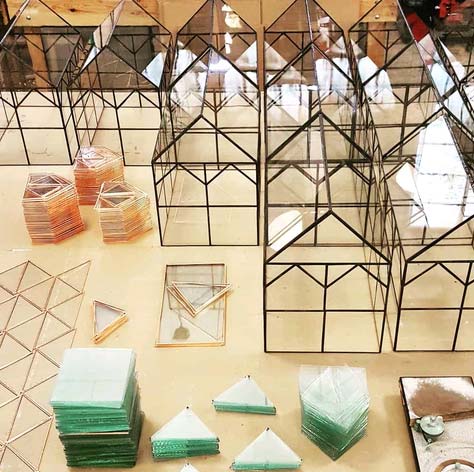

About LeadHead Glass
LeadHead Glass terrariums are handcrafted out of reclaimed glass from deconstructed homes. Our business was established in 2013 in Michigan by Chad and Derek. Both have a passion for stained glass and plants, and terrariums were a great way to combine those interests.
We model our terrariums after 19th century Wardian Cases, with a contemporary design. The Wardian case was originally used to transport exotic plants around the globe and is an ideal environment to raise your own miniature garden. Planting with a terrarium requires less water than traditional house plants. Each day condensation will form on the glass of your terrarium as it receives sunlight, then as the glass cools in the evening that moisture will return to the soil.
Each of our Terrariums are made using traditional stained glass techniques and are hand soldered. We knew from the start that we wanted to contribute in whatever small way to sustainability, so we chose to use recycled window glass for our terrariums. Window glass when disposed of is not recyclable and it has a different melting point and durability than standard glass items like bottles. Because of this most window glass ends up in a landfill.
Every LeadHead Glass Terrarium is handmade using traditional stained glass techniques and is as unique as the glass it comes from. Our commitment is to recycle and reuse our local resources by creating fine hand-crafted terrariums from reclaimed glass.
Planting and Care
What You'll Need
- LeadHead Glass Terrarium Liner (provided with terrarium)
- Red clay Pebbles (Hydrotron) or Pea Gravel
- Activated Charcoal (available at Garden Supply Stores)
- Potting Soil
- Terrarium Plants
Optional
- Coffee Filter
- Moss
- Sand
Step One
Add pebbles for drainage. Place a 1 inch high layer of pea gravel or red clay pebbles (Hydrotron) in the bottom of the LeadHead Glass terrarium liner. Hydrotron pebbles retain moisture and release it back to your plants roots as needed for healthy drainage.
Step Two
Next add a layer of charcoal. Add a 1/4 inch layer of activated charcoal pieces on top of your pebbles. Charcoal can be purchased at garden supply stores or aquarium supply stores. It is used to keep the soil purified and help with filtration.
Tip: Add a small coffee filter, layer of moss, or sand. This will prevent soil from filtering down into the pebbles, and provide helpful removal of water.
Step Three
Add Potting Soil. Add 2 to 3 inches of potting soil on top of the charcoal. We recommend using a good organic potting soil.
Tip: For planting succulents, use potting soil for cacti and succulents. This soil has a higher content of sand and perlite for increased drainage.
Step Four
Planting and Decorating. Remove the plant from its plastic container, tease the roots gently apart and remove any excess moisture. Dig a small hole in the potting soil and place the root ball inside. Add soil around the base of the plant and gently pat it down. Depending on the size of your terrarium, you may be able to add multiple plants. Consider adding decorative sand, moss, or objects to your taste.
Tip: Never plant tropical plants and succulents in the same terrarium. They have different drainage and moisture requirements.
Step Five
Cover and Place. Place your LeadHead Glass terrarium top onto the base and place in a sunny spot in your home. Enjoy.
Plant Care
Water
Your Terrarium will require watering about every other month. We recommend using a spray bottle to lightly mist the soil. Dew and water droplets will form on your terrarium and are good signs of the health of your environment. If the soil feels dry spray distilled or purified water evenly over the surface. If you see any algae or mold forming it means that you have over watered. Simply remove your LeadHead Glass top for a day to allow the excess water to evaporate.
Food
Fertilizing your terrarium is an important part of care. During the summer growing season, fertilizer should be applied every other month. Make sure that the fertilizer you choose is well diluted, and spay it on during your regular watering.
Light
Pick a sunny spot to place your terrarium; however, full sun is not required. Most plants will still thrive inside of a terrarium even in lower light. Try to place your terrarium in a place with a consistent temperature. Major fluctuations between hot and cold may affect your plants health.



